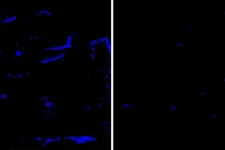(Press-News.org) Resistance to tangle formation may help preserve memory
SuperAgers have fewer tangles than normally aging individuals
Future research to see how SuperAgers are protected
CHICAGO - A new Northwestern Medicine study showed cognitive SuperAgers have resistance to the development of fibrous tangles in a brain region related to memory and which are known to be markers of Alzheimer's disease.
The tangles are made of the tau protein which forms structures that transport nutrients within the nerve cell. These tangles disrupt the cell's transport system, hampering communication within the neuron and preventing nutrients from performing their particular job within the cell. The end result of tangle formation is cell death.
"The results suggest resistance to age-related tau degeneration in the cortex may be one factor contributing to preserved memory in SuperAgers," said lead study author Tamar Gefen, an assistant professor of psychiatry and behavioral sciences at Northwestern University Feinberg School of Medicine.
"SuperAgers," a term coined by the Northwestern Mesulam Center for Cognitive Neurology and Alzheimer's Disease, are unique individuals over age 80 who show outstanding memory capacity at a level consistent with individuals 20 to 30 years younger. At the Center, SuperAgers are evaluated annually and may choose to donate their brains for post-mortem evaluation by Northwestern scientists.
This study quantified the amount of amyloid plaques and tau-containing neurofibrillary tangles in part of the brain that is heavily responsible for memory, known as the entorhinal cortex, in seven SuperAgers compared with six age-matched cognitively-healthy individuals. The findings showed significantly less tangles in the entorhinal cortex of SuperAgers than those of cognitively healthy controls by a difference of nearly three-fold.
"This finding helps us better identify the factors that may contribute to the preservation of memory in old age," Gefen said. "This research highlighted there are gradients of vulnerability to cell death in the brain."
"Individuals with significant memory impairment due to Alzheimer's disease showed nearly 100 times more tangles in the entorhinal cortex compared to SuperAgers," Gefen said. "There is a strong relationship between tau-tangles and memory loss, and these findings in a unique SuperAging cohort could guide research in a new direction."
The study, "Paucity of Entorhinal Cortex Pathology of the Alzheimer's Type in SuperAgers with Superior Memory Performance", was published in Cerebral Cortex on Feb. 17.
The seminal characteristics of Alzheimer's disease are amyloid plaques and tau-containing neurofibrillary tangles found in the brains of individuals at death after autopsy. While these plaques and tangles are most commonly found in the brains of those with memory impairment, they are also found in cognitively healthy elderly individuals but in a more limited distribution.
Because advancing age is typically associated with declining memory abilities and increased risk of developing Alzheimer's disease, the Center studies SuperAgers to better understand what is going right in their brains.
The study also found there were no significant differences in amyloid plaque density in SuperAgers compared to cognitively healthy older persons.
"Many investigators have long thought that amyloid plaques are drivers of memory loss, which isn't what we found," Gefen said.
Gefen wants to explore the interaction of genetics and environment/lifestyle, and their collective impact, on the cellular level in post-mortem brains of SuperAgers.
"Why are memory cells selectively vulnerable to tangles in the first place?" she asked. "What is it about the cellular environment in the brains of SuperAgers that seem to protect them from tangles? Are the behaviors of SuperAgers somehow building up resistance in the brain?"
"To address these questions, we can study the molecular, biochemical, and genetic components of these specific memory cells, in SuperAgers, that are typically targeted by Alzheimer's. And, certainly, we must take their personal narratives (history, proclivities, behaviors, cultures) into account when making conclusions about their unique neuroanatomic profiles."
INFORMATION:
Other Northwestern authors include Allegra Kawles, Beth Makowski-Woidan, Janessa Engelmeyer, Ivan Ayala, Payam Abbassian, Hui Zhang, Sandra Weintraub, Margaret Flanagan, Qinwen Mao, Eileen Bigio, Emily Rogalski, Marsel Mesulam and Changiz Geula.
The research was supported by grants P30AG013854, R01AG045571, 1R01AG067781, R01AG062566, R56AG045571 from the National Institute on Aging of the National Institute of Health.
Nearly a half-million people a year die from sudden cardiac death (SCD) in the U.S. -- the result of malfunctions in the heart's electrical system.
A leading cause of SCD in young athletes is arrhythmogenic cardiomyopathy (ACM), a genetic disease in which healthy heart muscle is replaced over time by scar tissue (fibrosis) and fat.
Stephen Chelko, an assistant professor of biomedical sciences at the Florida State University College of Medicine, has developed a better understanding of the pathological characteristics behind the disease, as well as promising avenues for ...
The trial found that using sensor-based asthma inhalers may improve control of the condition and improve the quality of life for caregivers.
Greatest gains were among non-Hispanic Black participants, who experience more frequent and severe asthma than other groups.
Based on the study results, this asthma intervention should be considered for use by primary care, allergy and pulmonary care providers, to help engage diverse populations of pediatric asthma patients and their caregivers.
CHICAGO (February 17, 2021) -- Sensor-based inhalers integrated into health care providers' clinical workflows may help improve medication adherence and support children with asthma - and their families - to more effectively manage this condition, according ...
Numerous studies have shown that trained dogs can detect many kinds of disease -- including lung, breast, ovarian, bladder, and prostate cancers, and possibly Covid-19 -- simply through smell. In some cases, involving prostate cancer for example, the dogs had a 99 percent success rate in detecting the disease by sniffing patients' urine samples.
But it takes time to train such dogs, and their availability and time is limited. Scientists have been hunting for ways of automating the amazing olfactory capabilities of the canine nose and brain, in a compact device. Now, a team of researchers at MIT and other institutions has come up with a system that can detect the chemical and microbial content of an air sample with ...
As people age, a normal brain protein known as amyloid beta often starts to collect into harmful amyloid plaques in the brain. Such plaques can be the first step on the path to Alzheimer's dementia. When they form around blood vessels in the brain, a condition known as cerebral amyloid angiopathy, the plaques also raise the risk of strokes.
Several antibodies that target amyloid plaques have been studied as experimental treatments for Alzheimer's disease. Such antibodies also may have the potential to treat cerebral amyloid angiopathy, although they haven't yet been evaluated in clinical trials. ...
An international team led by researchers at the Centre for Palaeogenetics in Stockholm has sequenced DNA recovered from mammoth remains that are up to 1.2 million years old. The analyses show that the Columbian mammoth that inhabited North America during the last ice age was a hybrid between the woolly mammoth and a previously unknown genetic lineage of mammoth. In addition, the study provides new insights into when and how fast mammoths became adapted to cold climate. These findings are published today in Nature.
Around one million years ago there were no woolly or Columbian mammoths, as they had not yet evolved. This was the time of their predecessor, the ...
DURHAM, N.C. -- A new pair of studies from a Duke research team's long-term work in New Zealand make the case that mental health struggles in early life can lead to poorer physical health and advanced aging in adulthood.
But because mental health problems peak early in life and can be identified, the researchers say that more investment in prompt mental health care could be used to prevent later diseases and lower societal healthcare costs.
"The same people who experience psychiatric conditions when they are young go on to experience excess age-related physical diseases and neurodegenerative diseases when they are older adults," explained Terrie Moffitt, the Nannerl O. Keohane professor ...
A University of Sydney-led international team of scientists has revealed the shape of one of the most important molecular machines in our cellsthe glutamate transporter, helping to explain how our brain cells communicate with one another.
Glutamate transporters are tiny proteins on the surface of all our cells that shut on and off the chemical signals that have a big role in making sure all cell-to-cell talk runs smoothly. They are also involved in nerve signalling, metabolism and learning and memory.
The researchers captured the transporters in exquisite detail using cryogenic electron microscopy (cryo-EM), showing they look like a 'twisted elevator' embedded in the cell membrane.
This world-first discovery ...
Almost one in five people lacks the protein α-actinin-3 in their muscle fibre. Researchers at Karolinska Institutet in Sweden now show that more of the skeletal muscle of these individuals comprises slow-twitch muscle fibres, which are more durable and energy-efficient and provide better tolerance to low temperatures than fast-twitch muscle fibres. The results are published in the scientific journal The American Journal of Human Genetics.
Skeletal muscle comprises fast-twitch (white) fibres that fatigue quickly and slow-twitch (red) fibres that are more resistant to fatigue. The protein α-actinin-3, which is found only ...
Robotic dogs, laughter therapy and mindfulness are some of the ways that might help people - particularly the elderly - cope with loneliness and social isolation while social distancing, say researchers at the University of Cambridge.
A team at Cambridge's School of Medicine carried out a systematic review looking at the existing evidence on different approaches to tackling loneliness and social isolation. While all the individual studies were carried out pre-pandemic, the team considered which approaches might be feasible when people are still required to socially distance. Their results are published today in PLOS ONE.
At the start of the pandemic in the UK, over 1.5 million people were told they must self-isolate ...
Lakes underneath the Antarctic ice sheet could be more hospitable than previously thought, allowing them to host more microbial life.
This is the finding of a new study that could help researchers determine the best spots to search for microbes that could be unique to the region, having been isolated and evolving alone for millions of years. The work could even provide insights into similar lakes beneath the surfaces of icy moons orbiting Jupiter and Saturn, and the southern ice cap on Mars.
Lakes can form beneath the thick ice sheet of Antarctica where the weight of ice causes immense pressure at the base, lowering the melting point of ice. This, coupled with gentle heating from rocks below and the insulation provided by the ice from the cold air above, allows pools of liquid water ...



